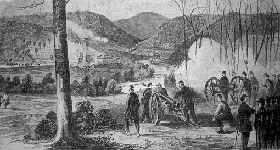Link To This Page — Contact Us —
The Battle of Philippi
June 3, 1861, in Philippi, West Virginia
 | |||||||||||||||||||||
|
The Battle of Philippi or "The Philippi Races" was fought as part of the Operations in Western Virginia Campaign. It is generally considered the first significant land action in the Eastern Theater of the war.
When the Virginia legislature voted to secede from the Union, most of the members from northwest Virginia voted against it. There were few slaves in this mountainous region of the state, and the area was more closely aligned with its northern neighbors, Ohio and Pennsylvania, than with the rest of Virginia. The region was strategic for both the Union and the Confederacy. The Baltimore & Ohio Railroad crossed it, linking the East with the Midwest; 3 major turnpikes ran through gaps in the Allegheny Mountains—the Northwestern, the Staunton to Parkersburg, and the James River and Kanawha; and the Great Kanawha Valley pointed toward Ohio, a potential invasion route. The Virginia Militia acted quickly to control the area and sent Col. Thomas J. Jackson to Harpers Ferry to secure the armory and arsenal and to organize the militia assembling there. The Confederates disrupted the B&O Railroad and seized control of the turnpikes.
While the western Virginians moved toward secession from Virginia, the Federal government moved in with military force. Maj. Gen. George B. McClellan assumed command of the Department of the Ohio to defend the Ohio River valley. General-in-Chief Winfield Scott directed McClellan to move 20,000 troops into the area. McClellan planned an offensive into Western Virginia that he hoped would eventually end up at Richmond. His immediate objectives were twofold: seize territory to protect the predominantly pro-Union populace of the area, and keep open the Baltimore & Ohio Railroad line, which was a critical supply line for the Union.
On May 26, McClellan ordered 3,000 troops under Brig. Gen. Thomas A. Morris into western Virginia in a two-pronged advance. The principal advance was by 1,600 men under Brig. Gen. Benjamin F. Kelley, which pushed toward Grafton and occupied it on May 30. The other advance, of 1,400 men under Brig. Gen. Ebenezer Dumont, took Webster, several miles to the west. When his forces occupied Grafton, an important junction on the railroad, the Confederates retreated 18 miles to Philippi. After some initial and inconclusive skirmishing around Grafton, the Confederates fell back to Phillipi in order to continue organizing their volunteers and militia forces.
McClellan was charged with securing the loyal counties of western Virginia and protecting the B&O Railroad. He sent troops across the Ohio River at Parkersburg in answer to the Confederate attacks on railroad bridges.
On June 2, the two forces departed by train to converge on Philippi—Kelley from the south and Dumont from the north—to execute a double envelopment of the 800 recruits commanded by Col. George A. Porterfield. Both columns arrived at Philippi before dawn on June 3. That morning, these Union troops surprised the Confederates in Philippi.
Brig. Gen. Thomas A. Morris had planned a 2-pronged attack on the town. Col. Ebenezer Dumont of the 7th Indiana Volunteers, with about 1,500 troops and 2 artillery pieces, would attack on the direct route from the northwest. When he reached the town, he established his cannons on the hill overlooking the covered bridge, and opened the attack from that point. Col. Benjamin F. Kelley of the 1st (West) Virginia volunteers was to move south from the railroad down to the Beverly-Fairmont Turnpike southeast of Philippi, then surprise the Confederates in their rear with his 1,900 men.
Morris planned a predawn assault that would be signaled by a pistol shot. The Confederate troops had failed to establish picket lines to provide perimeter security, choosing instead to escape the cold rain that fell at morning and stay inside their tents. A Confederate sympathizer, Mrs. Thomas Humphreys, saw the approaching Union troops and sent her young son on horseback to warn the Confederates. While Mrs. Humphreys watched, a Union outpost captured the boy and she fired her pistol at the Union soldiers. Although she missed, her shots started the attack prematurely.
The plan was frustrated by driving rain and unfamiliar terrain. The Union forces began firing their artillery, which awakened the sleeping Confederates. After firing a few shots at the advancing Union troops, the Southerners broke lines and began running frantically to the south, some still in their bed clothes, which caused critics to refer to the battle as the "Races at Philippi".
Dumont's troops entered the town from the north, but Kelley's arrived late and were unable to block the Confederate escape. Kelley himself was shot while chasing some of the retreating Confederates. There were two significant Confederate casualties, both were treated with battlefield amputations, believed to be the first such operations of the war. The remaining Confederate troops retreated to to Huttonsville. Surprised and outnumbered, the Confederates fled down the turnpike to Huttonsville, in an encounter often known as "the Philippi Races."
Not yet jaded by the horrific carnage that the Civil War would make routine, and eager for any morale and propaganda advantage, the Northern press played up the brief, inconclusive skirmish. Although the Confederate flight was seen as a debacle, and Porterfield lost his command, the Confederates did retain most of their troops, and the Union attempt to capture the entire force in one swoop failed.
The Union victory in a relatively bloodless battle propelled the young McClellan into the national spotlight, and he would soon be given command of all Union armies. The battle also inspired more vocal protests in the western part of Virginia against secession. A few days later in Wheeling, the Wheeling Convention nullified the Virginia ordinance of secession and named Francis H. Pierpont governor.

